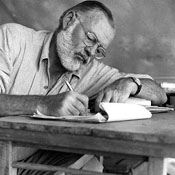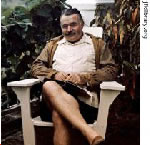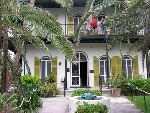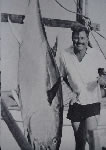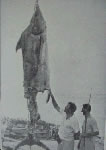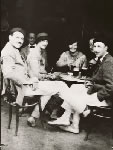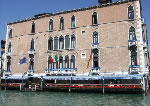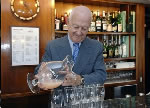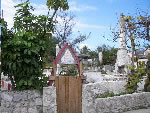Ernest Hemingway's Travels

Ernest Hemingway - Wild and Scenic Places
Ernest Hemingway traveled, hunted, fished, drank, fought and caroused famously on several continents - in Africa, Europe, Asia, Cuba, Bahamas, Key West, Michigan, Wyoming and many other spots. He is best known for his manly (some feel "muy macho") perspective on life - it is to be enjoyed in its every moment, for its pleasure and its pain - and millions read his works today in an attempt to relive and recreate the excitement he felt during his extensive travels from the 1920's through the 1950's. Raised in staid Oak Park, Illinois at the turn of the 20th century, Hemingway escaped his conservative Midwest roots to explore many wild and scenic places around the globe.
This author is a major fan of Hemingway - not just for his many wonderful novels, but also for his spirit of adventure, willingness to confront danger in pursuit of new experiences - and stoic attitude about life, often paraphrased as "grace under pressure". I have visited a few "Hemingway haunts" - Oak Park, Illinois; Key West; Sun Valley, Idaho; the wilds of Wyoming - and plan to see many more. In writing this piece, I wanted to share my experiences of having read all of his best known works and having visited some of the wonderful places he enjoyed so fully in his life.
Key West
Although Sloppy Joe's Saloon gets most of the notoriety in Key West as Hemingway's favorite watering hole - the original Sloppy Joe's started out around the corner in a place called Captain Tony's. Hemingway first visited Key West in 1928 in an attempt to change the pace from the cold Parisian nights he and wife Hadley endured for several years as he began his literary career. Key West in the 1930's - the period which Hemingway largely forged his reputation as an adventurer and first class writer - was viewed as "the St. Tropez of the poor", a hangout spot for drifters, down on their luck rum-runners and as a place to enjoy sport fishing. Not until Hemingway teamed up with his new friend Joe Russell in exploring the Gulf Stream and nearby Cuba on several lengthy fishing excursions did Key West gain a reputation as a place to enjoy world class fishing for marlin, yellow fin tuna and numerous other species.Today Key West retains numerous vestiges of Hemingway's life on the island - most notably Sloppy Joe's Saloon - but it has morphed into a haven for a largely "alternative lifestyle" demographic, holding annual "coming out" Fantasy Fest parades. The annual "Ernest Hemingway Look-Alike Contest" (July 17-20) has grown ever more popular. As Hemingway's stature rises through efforts to emulate his adventurous lifestyle, so will the popularity of Key West increase.
Hemingway in Cuba
The Finca Vigia ("lookout farm") in the hills of San Francisco de Paula outside Havana became Hemingway's home from 1939 until 1960, after the fall of the government to Cuban rebels led by Fidel Castro. Cuba is only a 90 mile cruise from Key West and Hemingway visited the island on fishing trips in his beloved Gulf Stream. Initially staying at the Ambos Mundos Hotel, he moved into his island home of nearly 20 years after his wife Pauline purchased the property in 1940. The superb sport fishing offered the newly purchased 38 foot boat Pilar (named for Pauline) a chance to cruise for giant marlin with its double engines and 100 mile functional radius. With the Pilar moored at Cojimar, a small fishing village which would provide the inspiration for his novella "The Old Man and the Sea", Hemingway built his fishing prowess and his reputation. One of Hemingway's favorite bars survives today - the El Floridita (where they mark his favorite spot with a plaque) and Americans who want to visit must make a circuitous route through a nearby country due to the official government ban on commerce between the two countries. Hemingway called the Floridita "the best bar in the world" and consumed numerous double daiquiris there (affectionately called "Papa Dobles"). Hemingway also enjoyed the Cuban mojito and quaffed many at the nearby La Bodeguita del Medio Bar; he often noted that he had his daiquiris at the Floridita and his mojitos at the Bodeguita).Visiting the Finca Vigia has become somewhat cumbersome over the years for the diehard Hemingway fans who want to walk in his footsteps. The Cuban government has take over the property as a national tourist site (the Museo Ernest Hemingway) and it prevents visitors from getting too intimate with the premises (now recovering with recent restorations after years of neglect). One cannot even take photographs - you must pay an official guide five dollars for that privilege. Nonetheless, the Finca and the nearby Gulf Stream remain popular tourist meccas for those wishing to recreate the robust 1950's environment when Ernest Hemingway became a legend. Driving in the hills around Havana and seeing the small fishing village of Cojimar may evoke the wondrous feelings which filled Hemingway's mind as he worked on some of his most famous novels, including "For Whom the Bell Tolls" and "Islands in the Stream".
Hemingway in Paris, France
The City of Lights wasn't as bright a beacon for Ernest Hemingway in the early - mid 1920's when he was just starting his career. Friends of Hemingway have indicated that he regularly went to the parks to catch pigeons which he and his family would eat for dinner due to a lack of money. Hemingway first arrived in Paris in December 1921 as the first foreign correspondent for the Toronto Star newspaper. He lived at 113 Rue Notre-Dame des Champs and claimed that the nearby La Closerie des Lilas was "one of the best cafes in Paris" to dine and work in solitude. This cafe is featured in his first acclaimed novel "The Sun Also Rises". Hemingway enjoyed the relative privacy of the cafe (compared to the bustling spots nearby), but was also joined on occasion by other literary giants, including F. Scott Fitzgerald, John dos Passos and Ezra Pound. Today the cafe has become an upscale brasserie with nightly jazz.Another Hemingway watering hole was the Hotel Ritz, which the author claimed to have "liberated" as the Allies were driving the Germans from the region in 1945 in the waning days of World War II. Hemingway was working as a foreign correspondent and enjoyed numerous rounds of martinis and magnums of champagne with his buddies at what then was called Le Petit Bar. Now renamed the Hemingway Bar, the oak paneled room with leather club chairs has been restored to its mid-20th century decor.
Hemingway in Venice, Italy
Harry's Bar in Venice is immortalized in the less well known Hemingway novel "Across the River and Into the Trees", in which the character Colonel Richard Cantwell downs martinis while falling in love with the young Venetian countess Renata. The novel has autobiographical content, as it was published in 1950 when Hemingway (who had experienced two World Wars) had fallen in love with a young Italian girl, Adriana Ivancich, 30 years his junior. Hemingway discovered Harry's Bar in 1949 and quickly became its most famous customer. The author enjoyed "The Montgomery", a "15-to-1" martini modeled on the famous British General Bernard Montgomery, who would often hesitate to attack unless he outnumbered his opponent by 15-to-one. The 15-to-one ratio is the Hemingway preferred ratio of gin to vermouth in the martini. The Montgomery is still a House special at Harry's Bar, where they currently prefer a 10-to-one ratio.Hemingway also enjoyed the superb duck hunting near Venice in the lagoon of the island of Torcella. The author took several hunting trips to the area, often staying at the home of Guiseppe Cipriani- the owner of Harry's Bar. There is today "The Harry's Bar Cookbook", which features "Anita Arrosto" (roast duckling), much as Hemingway would have liked it. Equally as well known in Venice is the Gritti Palace Hotel, where Hemingway and his fourth wife Mary enjoyed a third floor room with a magnificent view of the Grand Canal. The hotel, with its world class restaurant, is also mentioned in "Across the River and Into the Trees", with Colonel Cantwell and Renata dining in luxury after passionate encounters.
